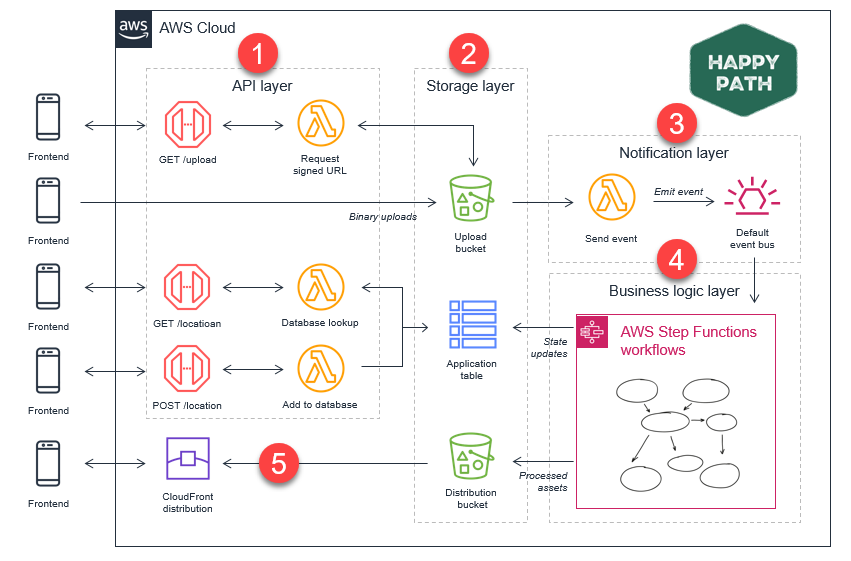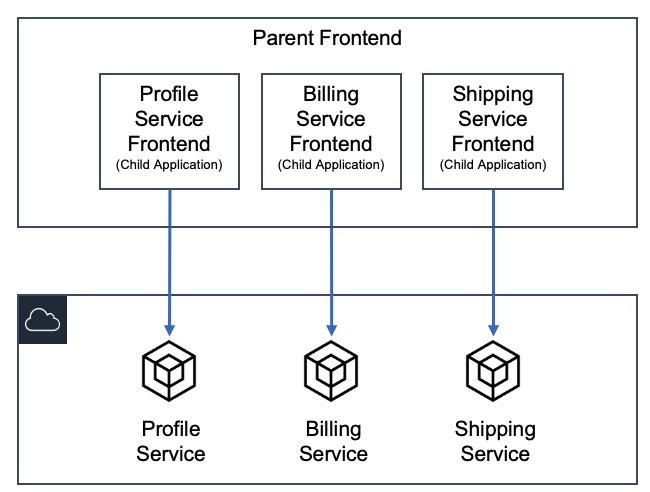- What is Cloud Computing?›
- Cloud Comparisons Hub›
- Application Integration›
- What’s the Difference Between Frontend and Backend in Application Development?
What’s the Difference Between Frontend and Backend in Application Development?
Page topics
- What’s the Difference Between Frontend and Backend in Application Development?
- How does the frontend of an application work?
- How does the backend of an application work?
- Key differences: frontend vs. backend
- Summary of differences: frontend vs. backend
- How can AWS support your application development?
What’s the Difference Between Frontend and Backend in Application Development?
Frontend and backend are two critical aspects of any application. The frontend is what your users see and includes visual elements like buttons, checkboxes, graphics, and text messages. It allows your users to interact with your application. The backend is the data and infrastructure that make your application work. It stores and processes application data for your users.
How does the frontend of an application work?
The term frontend refers to the graphical user interface (GUI) that your users can directly interact with, such as navigation menus, design elements, buttons, images, and graphs. In technical terms, a page or screen that your user sees with several UI components is called a document object model (DOM).
Three primary computer languages affect how your users interact with your frontend:
- HTML defines the frontend structure and the different DOM elements
- Cascading Style Sheets (CSS) defines the style of a web application, including layout, fonts, colors, and visual style
- JavaScript adds a layer of dynamic functionality by manipulating the DOM
JavaScript can trigger changes on a page and display new information. This means the frontend can handle fundamental user interactions (or requests), like displaying a calendar or checking if your user has entered a valid email address. The frontend passes on more complex requests to the backend.
How does the backend of an application work?
Sometimes called the server side, the backend of your application manages your web application's overall functionality. When your user interacts with the frontend, the interaction sends a request to the backend in HTTP format. The backend processes the request and returns a response.
When your backend processes a request, it usually interacts with the following:
- Database servers to retrieve or modify relevant data
- Microservices that perform a subset of the tasks your user requested
- Third-party APIs to gather additional information or perform additional functions
The backend uses several communication protocols and technologies to complete a request. Additionally, it handles thousands of distinct requests simultaneously. The backend combines concurrency and parallelism techniques, like distributing requests across many servers, caching, and data duplication.

Key differences: frontend vs. backend
Frontend and backend are broad terms that logically group any application's different technologies and software layers. The frontend focuses on those aspects your users can see. Conversely, the backend is everything that makes your application function.
You can think of the frontend as the exterior of a car and the backend as all the machinery inside. A beautifully designed car will only run optimally if the internal machinery works properly. However, certain aspects of exterior design also contribute to speed and performance. Similarly, your application's frontend and backend have to be designed cohesively for the best results.
Next, we discuss other key differences between frontend and backend.

Development goals
Full-stack development aims to create responsive, efficient, and functional applications. Frontend and backend developers have different goals to create the final application.
Frontend developers aim to develop a positive user experience, optimize the application for accessibility and performance, and create responsive designs. Their main development goals are to ensure the frontend is easy to interact with, well designed, and fully responsive on different platforms and devices.
Backend developers build and then maintain the server-side operations of an application. Their main development goals are to create reliable architecture that performs application functions accurately and efficiently. They aim to meet user requirements while fulfilling all security and cost considerations.
Technologies
Frontend development touches upon the user-facing side of a website. These technologies include computer languages like JavaScript, CSS, and HTML. Frontend software development also uses frontend frameworks to speed up production efficiency.
Backend development uses programming languages like Ruby, Java, and Python to write server-side logic. Backend developers also use databases, storage technologies, and API technologies so applications and systems communicate with each other.
Concurrency
Concurrency is the ability of an application to run multiple tasks simultaneously. On the frontend, every user has their own copy of an application in their browser or mobile app. This means that there are no concurrency issues with frontend development.
On the other hand, the backend may have to handle thousands of requests simultaneously. Backend developers use several strategies:
- Multi-threading to manage CPU processing of tasks
- Asynchronous programming like callbacks and promises
- Event-driven programming where the backend listens to multiple events and runs the appropriate event handlers concurrently
- Locking and synchronization techniques so multiple users can access the same resource simultaneously without inconsistencies
In a distributed computing approach, developers may divide backend tasks over multiple nodes so the backend manages data-intensive workloads concurrently.
Read about distributed computing »
Caching
Caching temporarily stores copies of application files, which makes them easier to retrieve the next time they are needed. You can use caching to improve an application's load time and performance.
On the frontend, a browser or the client application caches data like a header image the first time your user accesses it. The next time they access that same content, the frontend loads the cached files to improve performance.
Backend development uses caching to reduce the load on the application server. What you store in the backend cache depends on your application itself. Cached content includes static pages, database query results, API responses, session data, images, and videos.
One strategy is storing files on a content delivery network (CDN), which acts as an intermediary between the frontend and backend. Whenever a user makes a request on the frontend, the CDN checks if the data is available and responds directly.
Security
Frontend security focuses on user-facing components. These include input forms, client-side scripts, and the user experience in security workflows like authentication.
Common frontend development security strategies include input validation, disabling settings that allow your users to enter code in text boxes, and multifactor authentication workflows. Your user is responsible for several frontend security aspects, like keeping their password or device safe.
Backend security focuses on data security in storage and transit. It manages all aspects of authentication, access control, and session security. It covers all backend services, including connected databases, APIs, and server-side programming languages.
Core backend security practices include secure coding, encrypting sensitive data before and after transmission, and secure authorization and authentication systems.
Developer skills
Frontend developers understand the customer experience and accommodate user needs. Their primary skills involve proficiency in JavaScript, CSS, and HTML and design knowledge in creating visually appealing user flows. Frontend developers also learn several frontend frameworks and know how to conduct performance optimization.
Backend developers code application functions and make apps more secure, error-free, and fast. A backend developer is proficient in several programming languages like Python, Ruby, Java, and PHP. They know application development frameworks like Django, Ruby on Rails, and Laravel that integrate the frontend and backend. Backend developers also know how to manage and design relational and non-relational databases.
Full-stack developers have skills across both frontend and backend development.
Summary of differences: frontend vs. backend
|
Frontend |
Backend |
|
|
Technologies |
The frontend uses HTML, CSS, JavaScript, and frontend frameworks. |
The backend uses programming languages like Java, Python, Ruby, APIs, and database management systems. |
|
Concurrency |
Each user has their own copy of an application, so the frontend does not have to handle concurrency issues. |
The backend uses several strategies to handle thousands of user requests at the same time. |
|
Caching |
Browsers or client apps cache files from the application and use them to improve performance. |
Backend systems cache files in different servers or in a CDN. |
|
Security |
Security in frontend development is mostly the responsibility of the user. Frontend developers mainly focus on user input validation and user authentication workflows. |
Security in backend development is more comprehensive to protect databases, backend services, and the application itself. It’s achieved using encryption, secure authentication systems, and secure coding practices. |
|
Development Goals |
Frontend development focuses on creating fully functional, responsive, and well-designed user interfaces. |
Backend development involves creating reliable architecture that supports frontend development. |
|
Development Skills |
Frontend developers know HTML, CSS, and JavaScript. They can use frontend frameworks and create visually appealing pages. They unravel user pain points as they interact with the application. |
Backend developers have both coding and database management skills. They also understand code security and how to use application development tools, platforms, and frameworks. |
How can AWS support your application development?
Amazon Web Services (AWS) can support you in both frontend and backend development for all types of applications. For example, we can help you with coding environments, deployment, and hosting technologies.
Here are AWS services that can help you develop applications:
- AWS Amplify helps you rapidly build and scale full-stack web and mobile apps with ease
- AWS database services let you access a broad selection of purpose-built databases for all types of use cases
- AWS Lambda lets you create serverless applications without needing to worry about infrastructure management
The Solutions for Application Development & DevOps Library also provides various solutions for your application development challenges.
Get started with frontend and backend development on AWS by creating an account today.